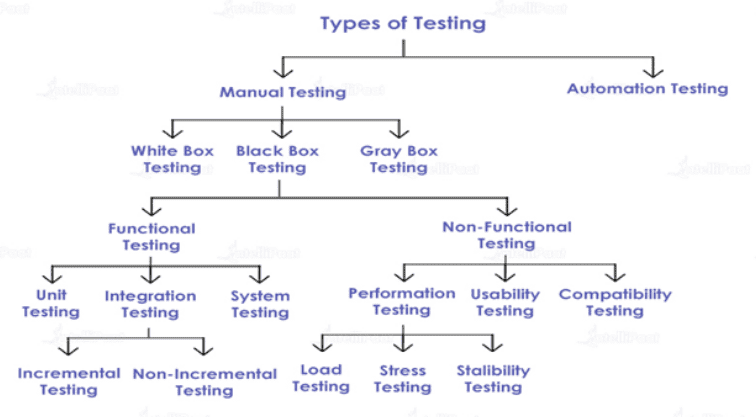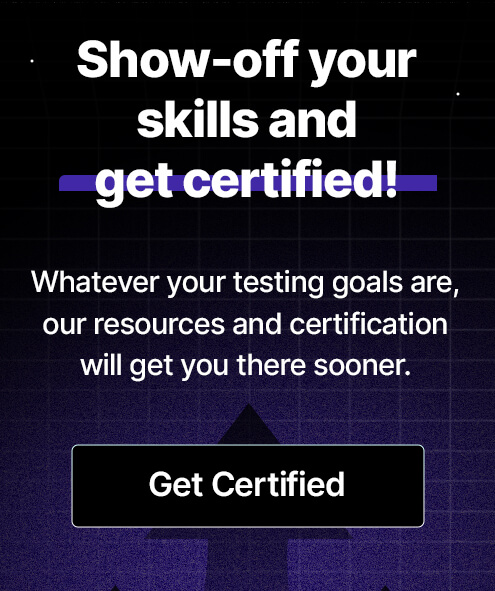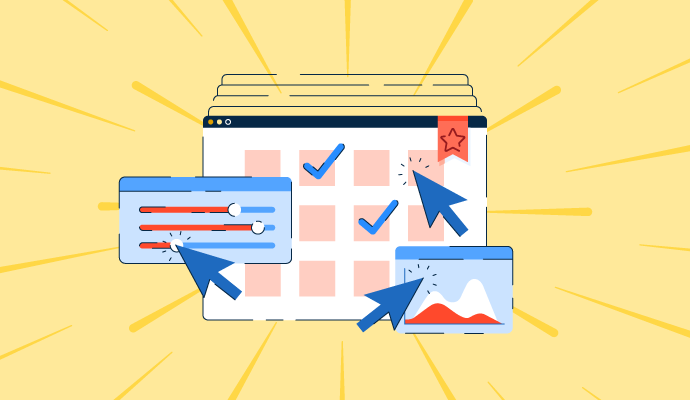Discover the 15 most important types of software testing, including unit testing, integration testing, system testing, and more. The post 15 Types of Software Testing Every QA Must Know About appeared first on ACCELQ Inc.
15 Types of Software Testing Every QA Must Know About

Software testing, as you might already know, is a fundamental part of SDLC (software development lifecycle). It helps us to ensure that the software we develop functions as expected and meets all the quality standards before it is released.
Whether you're new to software testing or have been doing it for years, software testers must be up-to-date about the latest software testing methodologies to ensure quality software development.
We have listed 15 different types of testing methods and classified them into three main categories first. Also, explain when to use each method depending on your software project.
Let’s look at the types of software testing for each category in detail.

Functional Software Testing
Functional software testing types help testers validate that the features of the software being developed are working as expected using the following methods.
1. Unit Testing
Unit testing is one of the core functional testing types that provides the foundation for verifying software behavior.
To elaborate, unit testing focuses on testing the functionality of individual units or components of code in isolation to verify each part operates correctly on its own.
Compared to other types of testing, the scope of unit tests is quite small and focuses mostly on validating things like
Developers usually do unit testing by writing various test cases to test their code. It helps them catch bugs early during coding before issues can multiply, saving the time and effort of dedicated software testers.
Example:
Scenario: Testing an “Email Validation” feature for a website’s sign-up page.
Purpose: This example demonstrates unit testing by focusing on a single feature - email validation and testing it with multiple inputs to ensure the results are perfect in different scenarios.
2. Integration Testing
Unlike unit testing, integration testing helps testers determine whether different modules or services work together harmoniously as intended.
That means after developers have conducted and verified that individual units are working properly, software testers combine those units and perform integration tests to test them as a group.
Specifically, integration testing helps check if the interface connections between units are working and verify that the integrated system meets the requirements.
This process helps to confirm that the units tested by developers independently are operating together when integrated.
Example:
Scenario: Testing the integration of an online payment gateway of an e-commerce website.
Purpose: This example demonstrates integration testing by focusing on how different system components (the e-commerce platform and the payment gateway) work together.
3. System Testing
System testing, as the name suggests, basically helps to evaluate the entire system and checks that it meets the overall functional requirements of the software application.
To verify this, this software testing method focuses on end-to-end business processes and workflows to test and confirm that the system is functioning as expected and intended.
To perform a system test, software testers need to perform the following:
After performing these tests, system testing finally gives testers the confidence that the overall solution will function as needed when it is finally deployed in the live environment.
Example:
Scenario: Testing the complete functionality of an airline reservation system.
Purpose: This example illustrates system testing by focusing on the entire airline reservation system. It assesses the system's overall functionality, ensuring it meets its intended requirements and specifications.
4. Acceptance Testing
Acceptance testing helps software testers confirm that the software meets all agreed business and user requirements and is acceptable for delivery.
This is done by testing the software application with the following three acceptance testing sub-types:
Unlike other functional testing types, acceptance testing is usually conducted in a production-like environment to thoroughly examine whether the software meets all validation criteria and is ready for go-live.
Example:
Scenario: Testing a new corporate project management software.
Purpose: This example demonstrates acceptance testing by focusing on how the end-users interact with the software and whether it fulfills their requirements and expectations.
Non-Functional Testing
Non-functional testing of every software is equally important as functional testing because these tests help us evaluate aspects like performance, security, usability, and reliability.
Here are the four most important non-functional testing types every software tester needs to know about.
5. Performance Testing
In layman’s terms, performance testing helps to check how fast the software performs under various conditions.
To elaborate, it mainly examines the overall responsiveness, stability, resource usage, and even scalability under both - normal & peak - conditions.
Like acceptance testing, performance testing also has sub-types that software testers must perform to evaluate the software.
These individual sub-tests help software testers identify the possible breaking points in the software and ensure that the software can handle the projected production loads.
In a nutshell, the performance sub-tests help to find bottlenecks, memory leaks, or software defects that could cause slow response times or could result in system crashes.
Example:
Scenario: Assessing the performance of an e-commerce website under high-traffic conditions.
Purpose: This example illustrates performance testing by evaluating how well the e-commerce website operates under stressful conditions.
6. Security Testing
As you can already guess, security testing allows software testers to identify vulnerabilities that could allow hackers to penetrate and compromise confidential data.
To prevent this, software testers need to conduct various security tests as described below:
Performing these different security tests will help you establish strong security and prevent any potential vulnerabilities that could lead to cyber-attacks, data breaches, and compliance violations.
As a software tester, it is imperative to learn how to conduct these tests to mitigate any security risks in your application.
Example:
Scenario: Evaluating the security measures of an online banking application to protect user data and transactions.
Purpose: This example demonstrates security testing by focusing on the robustness of the online banking application against potential cyber threats.
7. Usability Testing
Usability testing is more accessible for most software testers as it mainly involves evaluating how easy the application interface is for the end users.
To elaborate, the goal of usability testing is to check if any issues with navigation, controls, and the overall visual design of your software application could negatively impact the user experience.
To conduct successful usability tests, you need to learn to observe representative users carrying out tasks in your software application. This will help you to discover their pain points and opportunities to improve the UI design of your software.
Example:
Scenario: Assessing a mobile shopping application's user-friendliness and overall experience.
Purpose: This example illustrates usability testing by focusing on the end-user experience of the mobile shopping app.
8. Compatibility Testing
It is a must-have part of any software testing strategy because it helps to check and verify that your software application is functioning correctly across all target operating systems, browsers, devices, and software versions.
In layman’s terms, it helps software testers confirm that their software automatically and successfully adjusts and displays correctly across various devices, platforms, and configurations.
If you want to enhance your skillset as a software tester, learning how to conduct compatibility testing is critical for ensuring a consistent user experience in your application.
Example:
Scenario: Ensuring a video streaming service works effectively across different devices and browsers.
Purpose: This example demonstrates compatibility testing by focusing on how well the video streaming service operates across various hardware and software environments.
Other Types of Software Testing
Apart from the functional and non-functional testing methods, a few other software testing types are worth learning.
9. Ad-hoc Testing
Unlike most functional and non-functional testing types, the Ad-hoc testing method takes an informal approach to validating software.
This software testing method does not rely on predefined test cases. Instead, software testers usually create dynamic tests on the fly based on their knowledge and experience.
Thanks to this, software testers can quickly identify defects generally missed by formal testing methods. The flexibility of ad-hoc testing allows you to be reactive and test things you didn’t initially plan for.
Plus, as you conduct ad-hoc tests across multiple projects, you’ll soon develop the intuition and skills to perform ad-hoc testing effectively over time.
Example:
Scenario: Randomly testing various features of a social media application without any specific plan or test cases.
Purpose: This example illustrates ad-hoc testing by focusing on the spontaneous and unscripted exploration of the social media app. It helps uncover issues that might not be found through structured testing methods, providing insights into the app's robustness and user experience under less predictable conditions.
10. Back-end Testing
Back-end testing focuses on validating all the behind-the-scenes components that power the front-end application users interact with.
It aims to ensure all the behind-the-scenes functionality works correctly before the software goes live.
In a nutshell, performing rigorous back-end testing is critical for every software tester to catch severe defects and improve the stability as well as the performance of the final product.
Example:
Scenario: Testing an online booking system's server-side (back-end) functionalities.
Purpose: This example demonstrates back-end testing by focusing on the server-side components of the online booking system.
11. Backward Compatibility Testing
This software testing type helps check and validate whether the newly developed or launched software works well with the older environment version.
Why is this important? - Many companies have old, legacy systems and data the software needs to interact with. But sometimes, upgrading to a new version could create problems with these legacy pieces. This is exactly where backward compatibility software testing helps by preventing these issues from developing in the first place.
For example, say you upgrade an HR system to a new version. Backward compatibility testing would validate:
Without solid backward compatibility testing, upgrades risk unknowingly damaging connections to old systems still in use.
This software testing method helps to manage and prevent issues when transitioning between software versions.
Example:
Scenario: Ensuring a new version of a productivity software suite is compatible with files created in older versions.
Purpose: This example illustrates backward compatibility testing by focusing on the software's ability to function seamlessly with files and data created in older versions.
12. Maintenance & Regression Testing
Maintenance and regression testing are practices that validate that software continues to function correctly after changes.
Maintenance testing is conducted on modified or enhanced software to ensure new features or bug fixes do not unintentionally affect the overall functionality.
Regression testing is mostly about re-running test cases you have developed on previous versions of the software whenever updates are made. The goal of regression testing is to check and ensure that existing functionality did not break as a result of maintenance changes.
Example:
Scenario: Testing an updated version of a corporate Customer Relationship Management (CRM) system to ensure new updates haven't adversely affected existing functionalities.
Purpose: This example demonstrates maintenance and regression testing by focusing on the stability and reliability of the CRM system after updates or modifications.
13. Mobile App Testing
Tests software applications designed to run on mobile devices such as smartphones and tablets.
It involves UI/UX, functional, security, compatibility, performance, and network traffic testing to validate the mobile application's overall usability, functionality, and reliability across all intended devices and conditions.
As a software tester, you must make sure that the app is easy and intuitive to navigate on smaller screens, works without any issues across different phone models, and, most importantly, double-check that it keeps your users’ data safe and secure.
The main goal is to remove any glitches or frustrations before people download your app and ensure smooth performance and great user experience so that your users keep coming back.
Example:
Scenario: Testing a fitness tracking app across various mobile devices and operating systems.
Purpose: This example illustrates mobile app testing by focusing on the app's performance and usability across a wide range of mobile devices and operating systems.
14. API Testing
API testing is about ensuring these API connections work as expected. It involves mimicking how an actual application would interact with an API and validating that the API behaves correctly.
API testing helps you to test things like:
API testing aims to uncover issues, including bugs, performance problems, or security vulnerabilities before the API goes live in production. Furthermore, It mitigates the risks of deploying buggy or vulnerable APIs that could cause widespread problems.
Comprehensive API testing is indispensable for building stable, scalable, secure software applications.
Example:
Scenario: Testing the APIs of a travel booking service that integrates with various airlines and hotels.
Purpose: This example demonstrates API testing by focusing on the functionality, reliability, and performance of the APIs used by the travel booking service.
15. Automated Testing
Last but not least, automated testing refers to test processes that run automatically without direct human input. It involves using various testing tools to automate the execution of tests on a software application.
The best part? - You can automate many of the functional & non-functional testing types, such as unit testing, integration testing, regression testing, acceptance testing, and more.
Example:
Scenario: Testing the APIs of a travel booking service that integrates with various airlines and hotels.
Purpose: This example illustrates automated testing by focusing on using software tools to test the online retail website's functionalities repeatedly. l
Quick Recap - Comparison of Software Testing Types
| Functional Testing | Validates intended behaviors and functionality from a user’s perspective. |
| Unit Testing | Tests individual code components in isolation early in development. |
| Integration Testing | Tests interactions between integrated modules after unit testing. |
| System Testing | End-to-end validation of the entire system to meet requirements. |
| Acceptance Testing | Confirms system acceptability by end users like UAT (user acceptance testing). |
| Non-Functional Testing | Validates non-functional aspects like performance, security, etc. |
| Performance Testing | Tests behavior under expected and peak workloads. Load/stress testing done. |
| Security Testing | Identifies vulnerabilities and weaknesses compromising security. |
| Usability Testing | Evaluates ease of use and navigation from a user perspective. |
| Compatibility Testing | Validates working across environments, browsers, devices, etc. |
| Other Software Testing Types | Specialized testing types that can’t be part of functional and non-functional testing categories. |
| Ad-hoc Testing | Unplanned exploratory testing without test cases. |
| Back-end Testing | Validates server-side components and logic. |
| Regression Testing | Retests the existing features after modifications. |
| Mobile App Testing | Validates functionality, UI/UX, etc. on mobile devices. |
| API Testing | Validates application programming interfaces meet specs. |
| Automated Testing | Testing is done using automation tools and frameworks. |
What’s the Ideal Software Testing Approach for Your Project?
While we covered a lot of ground by looking at 15 different software testing types, you still need to figure out which are ideal for your software project.
Hopefully, this post will serve as a helpful starting point as you explore which software testing strategies are right for your specific needs.
Remember, testing is not just about finding bugs - it is an indispensable process for building trust and confidence in your software products. Therefore, you must think about software testing holistically across the entire development lifecycle and employ a diverse toolkit of complementary testing methods.
ACCELQ, a comprehensive test automation platform, has proven itself to be a game-changer in streamlining and enhancing the software testing process. With its innovative features and capabilities, testing teams can achieve higher efficiency, accuracy, and agility in their testing efforts.
Geosley Andrades
Director, Product Evangelist at ACCELQ
Geosley is a Test Automation Evangelist and Community builder at ACCELQ. Being passionate about continuous learning, Geosley helps ACCELQ with innovative solutions to transform test automation to be simpler, more reliable, and sustainable for the real world.







 View Entire Post
View Entire Post










